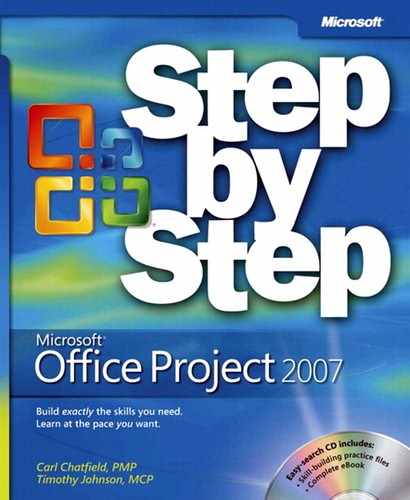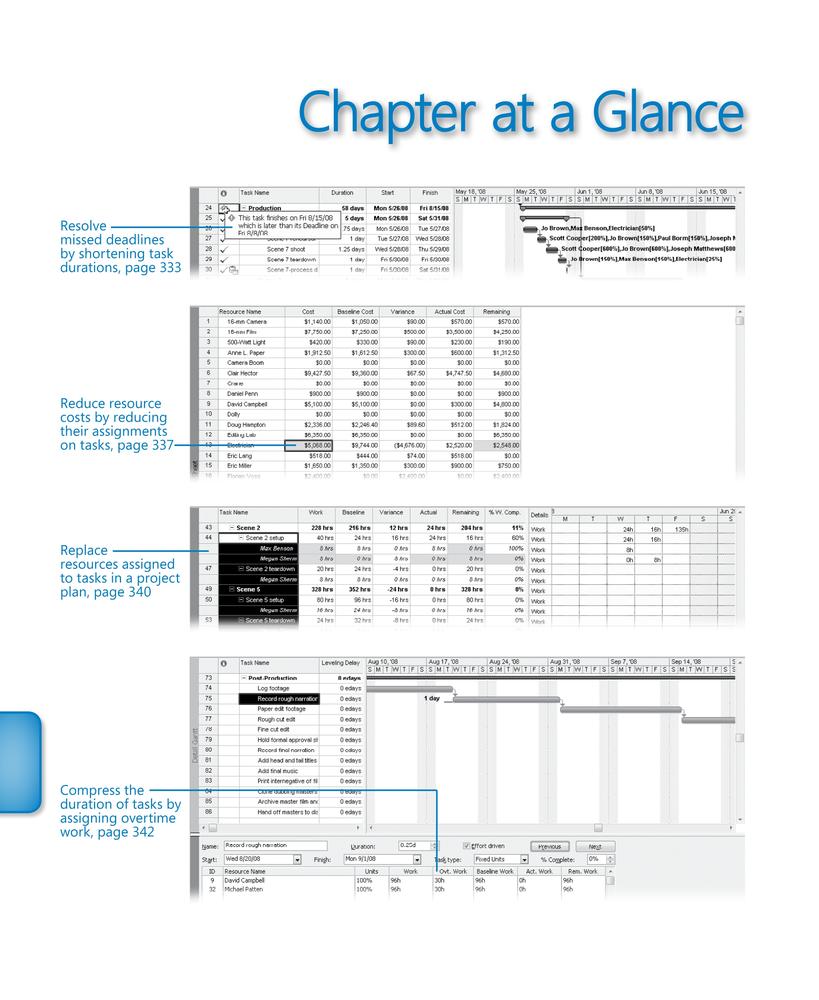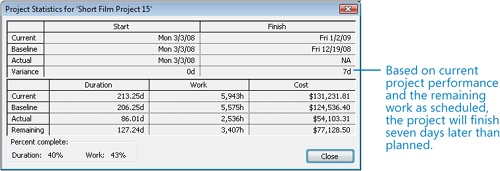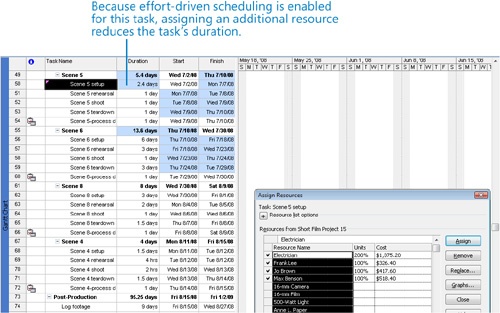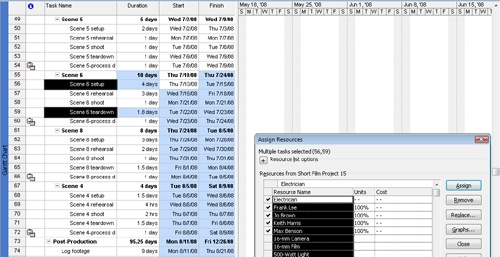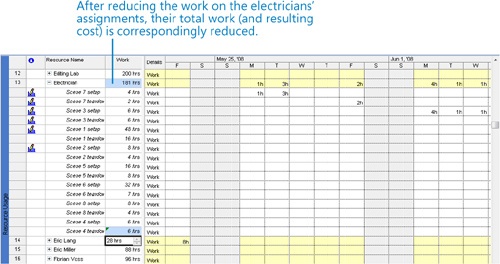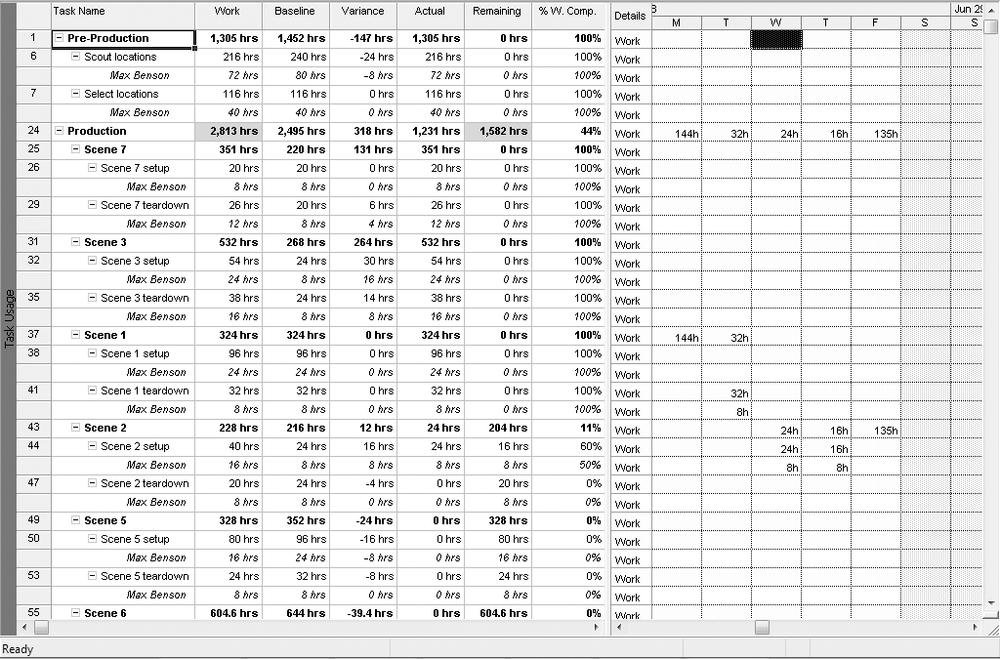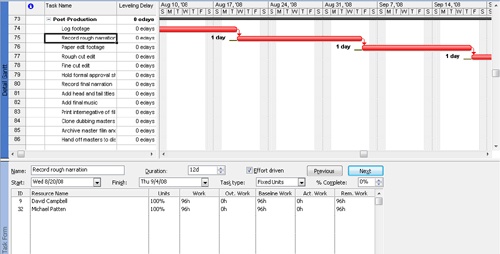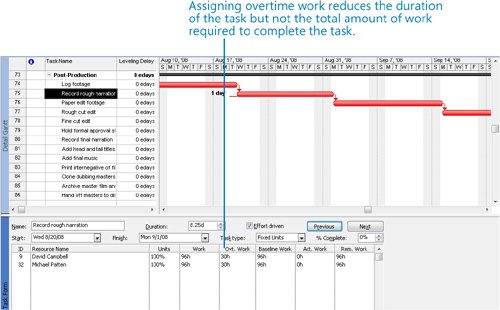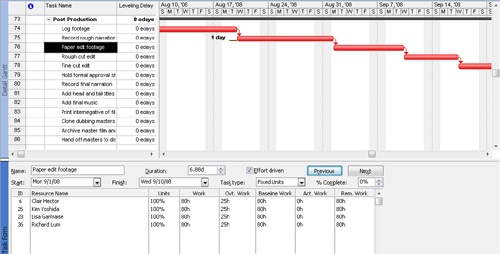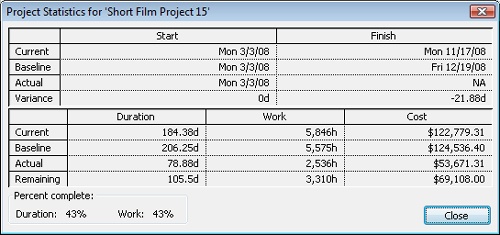Chapter 15. Getting Your Project Back on Track
In this chapter, you will learn how to: | |
✓ | Assign additional resources to tasks to reduce task durations. |
✓ | Edit work values for resource assignments and replace resources assigned to tasks. |
✓ | Assign overtime work to assignments and change task relationships to compress the overall project duration. |
Tip
Do you need only a quick refresher on the topics in this chapter? See the Quick Reference entries in Getting Your Project Back on Track.
After work has started on a project, addressing variance is not a one-time event, but instead is an ongoing effort by the project manager. The specific way in which you should respond to variance depends on the type of variance and the nature of the project. In this chapter, we’ll focus on some of the many variance problems that can arise during a project as work progresses. We’ll frame these problems around the project triangle described in detail in Appendix A.
In short, the project triangle model frames a project in terms of time (or duration), cost (or budget), and scope (the project work required to produce a satisfactory deliverable).
In virtually any project of any complexity, one of these factors will be more important than the other two. The most important factor is sometimes called the driving constraint because meeting it drives your actions as a project manager. For example, for a project that must be concluded by a specific date, you might need to make cost and scope compromises to meet the deadline. Working with the project triangle provides you with a good method to analyze the trade-offs that nearly always must be made in projects. Just as importantly, it gives you a clear way of explaining the pros and cons of trade-offs to the project’s resources, sponsors, and other stakeholders.
In the project triangle model, time, cost, and scope are interconnected; therefore, changing one element can affect the other two. For purposes of identifying, analyzing, and addressing problems in project management, it’s useful to fit problems into one of these three categories.
The specific issues that we’ll focus on in this chapter are not necessarily the most common problems you’ll face in your own projects. Because every project is unique, there’s no way to anticipate what you’ll run into. However, we’ve attempted to highlight the most pressing issues at the midpoint of the short film project’s duration and apply solutions to many common problems. Note that some of the features you’ll use in this chapter are those that you might also use when planning a project. Here, however, your intent is different—getting the project plan back on track.
Important
Before you can use the practice files provided for this chapter, you need to install them from the book’s companion CD to their default locations. See "Using the Book’s CD" for more information.
Troubleshooting Time and Schedule Problems
Schedule variance will almost certainly appear in any lengthy project. Maintaining control over the schedule requires that the project manager know when variance has occurred and to what extent, and then take timely corrective action to stay on track. To help you identify when variance has occurred, the short film project plan includes the following:
Deadline dates applied to key milestones
A project baseline against which you can compare actual performance
The deadline dates and project baseline will help you troubleshoot time and schedule problems in Microsoft Office Project 2007. In this exercise, you address the missed deadline for the production phase of the short film project and shorten the durations of some tasks on the critical path.
Important
If you are running Project Professional, you may need to make a one-time adjustment to use the My Computer account and to work offline. This ensures that the practice files you work with in this chapter do not affect your Project Server data. For more information, see "Starting Project Professional“.
Note
OPEN Short Film Project 15a from the DocumentsMicrosoft PressProject 2007 SBSChapter 15 Getting Back on Track folder. You can also access the practice files for this book by clicking Start, All Programs, Microsoft Press, Project 2007 Step by Step, and then selecting the chapter folder of the file you want to open.
On the File menu, click Save As.
The Save As dialog box appears.
In the File name box, type Short Film Project 15, and then click Save.
To begin troubleshooting the time and schedule issues, you’ll get a top-level view of the degree of schedule variance in the project plan to date.
On the Project menu, click Project Information.
The Project Information dialog box appears.
Next, you will look at the duration values for this project.
In the Project Information dialog box, click the Statistics button.
The Project Statistics dialog box appears:
In the dialog box, you can see the scheduled finish date for the project: January 2, 2009. However, you know this date must be pulled in so that the project concludes before the 2008 holiday season. You can also see that, overall, the project plan now has seven days of finish variance.
The Project Statistics dialog box also indicates some cost variance—the difference between the current and baseline cost values. You will examine this more closely in a later exercise.
Click Close to close the Project Statistics dialog box.
Before you address the overall project duration, you’ll examine the missed deadline for the production phase.
Point to the missed deadline indicator in the Indicators column for task 24, the Production summary task.
Enough schedule variance has occurred in the pre-production phase and the completed portion of the production phase to cause the scheduled completion of the production phase to move out beyond its deadline date of August 8.
Take a moment to look over the remaining tasks in the production phase, which consist of several more scenes to be shot. Because of the nature of this work, you cannot change task relationships (for example, from finish-to-start to start-to-start) to decrease the duration of each scene’s summary task; the tasks follow a logical finish-to-start relationship. Nor can you schedule two or more scenes to be shot in parallel because many of the same resources are required for all of them. To bring the production phase back down to an acceptable duration, you’ll have to shorten the duration of some of its subtasks. To do this, you’ll assign additional resources to some tasks.
Looking over the remaining production tasks, you see that some of the setup and teardown tasks seem to be the longest, so you’ll focus on these.
Click the name of task 50, Scene 5 setup, and then scroll the Gantt Chart view up so the task appears at the top of the view.
This three-day task currently has several resources assigned. After conferring with these resources, you all agree that they could complete the task more quickly with additional resources.
On the Standard toolbar, click the Assign Resources button.
In the Assign Resources dialog box, under the Resource Name column, click Frank Lee, and then click the Assign button.
Troubleshooting
If Project displays a Planning Wizard message here, click Continue and then OK. It will not affect the resource assignment.
Project assigns Frank Lee to the task; because effort-driven scheduling is enabled for this task, Project reduces the duration of the task to 2.4 days. The total work on the task is unchanged, but it is now distributed across more resources, thereby resulting in a shorter duration.
To further reduce the task’s duration, you’ll assign another resource.
In the Resource Name column, click Keith Harris, and then click Assign.
Project further reduces the duration of the task to two days.
Next, you will reduce the durations of the setup and teardown tasks of Scene 6. This time, however, you’ll make multiple assignments to multiple tasks simultaneously because it’s quicker.
In the Task Name column, click the name of task 56, Scene 6 setup. While holding down the
 key, click the name of task 59, Scene 6 teardown.
key, click the name of task 59, Scene 6 teardown.In the Resource Name column of the Assign Resources dialog box, click Frank Lee and then while holding down the
 key click Keith
Harris.
key click Keith
Harris.Click Assign.
Project assigns these two resources to tasks 56 and 59 and correspondingly reduces the durations of the two tasks.
Scroll up to see task 24, the Production summary task.
Note that the missed deadline indicator is still visible. If you point at it with your mouse pointer, you’ll see that the additional assignments you just made did indeed move in the completion date of the production phase, but not quite enough to meet its deadline date. To remedy this, you’ll make some additional assignments to other tasks.
In the Task Name column, click the name of task 62, Scene 8 setup. While holding down the
 key, click the name of task 65, Scene 8 teardown.
key, click the name of task 65, Scene 8 teardown.In the Resource Name column of the Assign Resources dialog box, click Frank Lee and then, while holding down the
 key, click Keith
Harris.
key, click Keith
Harris.Click Assign.
Click Close to close the Assign Resources dialog box.
Scroll up to see task 24, the Production summary task.
The missed deadline indicator is gone. Next, you’ll see how the production phase is now scheduled. Recall that the deadline date of the Production summary task was August 8.
On the Edit menu, click Go To.
In the Date box (not the ID box), type or click 8/8/08, and then click OK.
Project scrolls the Gantt Chart to show the end of the Production summary task.
With the updated setup and teardown durations, the overall duration of the production phase now ends on August 7, just prior to its deadline. However, given the amount of variance that occurred in the production phase already, you should keep a close watch on this phase as work progresses.
Troubleshooting Cost and Resource Problems
In projects where you’ve entered cost information for resources, you might find that you must fine-tune resource and assignment details to address many cost problems. Although this might not be your intention, changing resource assignment details not only affects costs, but can affect task durations as well.
As you saw in the previous exercise, the short film project plan has some cost variance. As it is currently scheduled, the project plan will end up costing about $5,000 more than planned, or about 4% over budget. This cost variance has resulted from some longer-than-expected assignment durations and the resulting increased costs of the assigned resources.
After researching the high cost of the electricians on the setup and teardown assignments, you discover that, in most cases, they’re really needed for only a portion of the tasks’ durations. After discussing the issue with the production manager, you agree that the electricians’ assignments on the remaining setup and teardown tasks should be halved. While you’re updating the project, you’ll also handle the upcoming departure of another resource.
In this exercise, you adjust work values for resource assignments and replace one resource with another on upcoming assignments. You begin, however, by checking the total cost of the electricians’ assignments.
On the View menu, click Resource Sheet.
On the View menu, point to Table: Entry and then click Cost.
The Cost table appears in the Resource Sheet view. Note the current total cost of resource 13, Electrician: $7,784. This figure is a combination of the electricians’ actual cost to date and their anticipated cost for scheduled assignments yet to be completed. You would like to reduce this cost by reducing the electricians’ work on upcoming tasks.
On the View menu, click Resource Usage.
The Resource Usage view appears.
In the Resource Name column, click the plus sign next to the name of resource 13, Electrician.
The Electricians’ assignments are displayed.
Because Scenes 7, 3, and 1 have already been completed, you’ll focus on the electricians’ assignments to the remaining scenes.
On the Standard toolbar, click the Scroll To Task button.
Project scrolls the timephased grid portion of the Resource Usage view so that some of the electricians’ assignments are visible. As you edit assignment work values in the steps below, you can scroll the timephased grid to see the effect on the scheduled work per day.
In the Work column in the table in the left pane for Scene 2 setup, type 8h, and then press the
 key.
key.Project adjusts the work of the electricians on this task to four hours.
In the Work column, enter the new work values in the following list for the electricians’ remaining assignments:
For this assignment
Enter this work value
Scene 2 teardown
4h
Scene 5 setup
16h
Scene 5 teardown
8h
Scene 6 setup
32h
Scene 6 teardown
7h
Scene 8 setup
8h
Scene 8 teardown
4h
Scene 4 setup
6h
Scene 4 teardown
6h
Note that because the electricians were not the only resource assigned to these tasks, reducing the electricians’ scheduled work in this way will reduce the cost of their assignments, but not necessarily the durations of these tasks. The other resources assigned to these tasks may have assignments of longer durations.
To verify the reduction in the electricians’ costs, you’ll switch back to the Resource Sheet view.
On the View menu, click Resource Sheet.
The Resource Sheet view appears.
Note the updated total cost of resource 13, Electrician: $5,068. Only the Cost and Remaining Cost values changed; the costs relating to work already performed (that is, actual work) are not affected, nor is the baseline cost.
To conclude this exercise, you will update the project plan to reflect that a resource will be leaving the project early and his assignments will be taken over by another resource. Max Benson will be leaving the project just after the start of work on Scene 2. You will reassign Max Benson’s work on subsequent tasks to Megan Sherman. Megan happens to be a slightly less expensive resource, so the replacement will help slightly with the cost variance as well.
On the View menu, click Task Usage.
The Task Usage view appears.
On the View menu, point to Table: Usage and then click Work.
The Work table appears in the Task Usage view.
Drag the vertical divider bar to the right to show the Percent Work Complete column (labeled % W. Comp).
Next, you’ll filter the Task Usage view to show only those tasks to which Max Benson is assigned. In that way, when you replace Max Benson with Megan Sherman, the replacement will affect only the tasks to which Max Benson is assigned.
On the Project menu, point to Filtered For: All Tasks, and then click Using Resource.
The Using Resource dialog box appears.
In the Show Tasks Using box, click Max Benson, and then click OK.
Project filters the Task Usage view to show only those tasks to which Max Benson is assigned.
Looking at the Percent Work Complete field, you can see that Max has uncompleted work starting with task 44 and concluding with task 71. You can see in the Percent Work Complete column that Max Benson’s assignment to task 44, Scene 2 setup, is 50% complete.
In the Task Name column, select the task names and assignments for tasks 44 through 71.
Next, you will make the resource replacement. Keep an eye on Max Benson’s partial work on task 44.
On the Standard toolbar, click Assign Resources.
The Assign Resources dialog box appears.
In the Resource Name column, click Max Benson, and then click the Replace button.
The Replace Resource dialog box appears.
In the Resource Name column, click Megan Sherman, and then click OK.
Project replaces Max Benson’s future assignments with Megan Sherman.
Click Close to close the Assign Resources dialog box.
Note that for task 44, Project preserved Max Benson’s eight hours of actual work on the task and assigned the remaining work on the task (also eight hours) to Megan. For the subsequent tasks to which Max was assigned, he has been replaced by Megan.
On the Project menu, point to Filtered For: Using Resource, and then click All Tasks.
Project unfilters the Task Usage view.
Troubleshooting Scope-of-Work Problems
A project’s scope should include all of the work required—and only the work required—to successfully deliver the product of the project to its intended customer. After project work has started, managing its scope usually requires making trade-offs: trading time for money, quality for time, and so on. You might have the goal of never making such trade-offs, but a more realistic goal might be to make the best-informed trade-offs possible.
Recall from the previous exercises that the project finish date extended into 2009. With the actions taken in the previous exercise, the finish date has been pulled into late December 2008, but you want it to end around mid-December 2008 at the latest. In this exercise, you focus on the project’s finish date and make several trade-offs to ensure that the project will deliver its product within the time frame that you want.
On the Project menu, click Project Information.
The Project Information dialog box appears. As the project is now scheduled, it will be completed on December 22, 2008—that is, if all of the remaining work is completed as scheduled. However, realistically, you expect the holiday season to interfere with concluding the project, so you’ll need to take steps to pull in the finish date.
Click Cancel to close the Project Information dialog box.
Because the project finish date is controlled by tasks on the critical path, you’ll begin by viewing only those tasks.
On the View menu, click More Views.
In the More Views dialog box, click Detail Gantt, and then click the Apply button.
The Detail Gantt view appears.
On the Project menu, point to Filtered For: All Tasks, and then click Critical.
Project displays only the critical tasks. The remaining production tasks are already as compressed as they can be, so you’ll focus on compressing the post-production tasks. To begin, you’ll allow overtime work for several tasks to shorten their durations.
On the Edit menu, click Go To.
In the ID box, type 75, and then click OK.
Project displays task 75, Record rough narration.
To see the effect of the following steps on the duration of task 75 and successor tasks, scroll the Detail Gantt view in the upper pane until task 75 appears near the top of the screen.
On the Window menu, click Split.
The Task Form appears below the Detail Gantt view.
Click anywhere in the Task Form. Then, on the Format menu, point to Details, and click Resource Work.
The Resource Work details appear in the Task Form.
In the Task Form, in the Ovt. Work column for the resource named David Campbell, type or click 30h, and press
 .
.In the Ovt. Work column for Michael Patten, type or click 30h, and click OK in the upper right corner of the Task Form.
The overtime work values cause Project to adjust the daily work assignments for these resources and shorten the overall duration of the task.
Note that each resource’s total work on this task remains at 96 hours. Now, however, 30 of those 96 hours per resource will be scheduled as overtime. The same amount of work will be performed, but in a shorter time span. Project will apply overtime cost rates, if they have been set up, to the overtime portion of the assignment.
In the Gantt Chart view, click the name of task 76, Paper edit footage.
In the Task Form, enter 25 hours (25h) of overtime work for each of the four assigned resources, and then click OK.
Project schedules the overtime work and recalculates the task’s duration.
On the Window menu, click Remove Split.
On the Project menu, click Project Information.
The Project Information dialog box appears. The adjustments you’ve made to the schedule have pulled in the project’s finish date to 12/11/08. Although that meets the target you had in mind, you can expect some additional variance given the overall performance to date. In anticipation of this, you’ll make further adjustments to the post-production tasks.
Click Cancel to close the Project Information dialog box.
In the Task Name column, click the name of task 83, Print internegative of film.
Task 83, Print internegative of film, isn’t really dependent on its predecessor being completed before it can start and does not use the same resources as its predecessor. After talking with the resources assigned to it and its predecessor task, you all agree that, given the schedule crunch, work on task 83 can begin at the same time as its predecessor, task 82.
On the Standard toolbar, click the Task Information button.
The Task Information dialog box appears.
Click the Predecessors tab.
In the Type field for the task’s predecessor, click Start-to-Start (SS) on the drop-down list.
Click OK to close the Task Information dialog box.
On the Standard toolbar, click Scroll To Task.
Project reschedules task 83 to start when task 82 starts and reschedules all subsequent linked tasks as well. Note that task 84 will now start and end before task 82 is completed.
On the Project menu, click Project Information.
The Project Information dialog box appears. The project’s finish date is now pulled back to mid November—a workable date at this time.
To conclude this exercise, you’ll see what effects these final adjustments have had on the project’s final cost values as well.
Click Statistics.
The Project Statistics dialog box appears.
The project’s current cost calculation is now slightly below the baseline cost, although you know it’s likely to go up as the remainder of the project experiences more variance.
Click Close to close the Project Statistics dialog box.
You confer with the project sponsors, who are pleased that you can wrap up the short film project before the holiday season. Although producing the project deliverable within these constraints will be a challenge, you’re both realistic and optimistic about the project’s future performance and comfortable with your project management skills and knowledge of Project. Good luck!
Key Points
When addressing variance in a project plan, it is useful to evaluate your plan (and variance) in terms of time, cost, and scope: the three sides of the project triangle.
When addressing schedule problems, focus your remedies on tasks on the critical path; these drive the finish date of the project.
When addressing cost or scope problems, focus on expensive resources and especially on their longer assignments.
